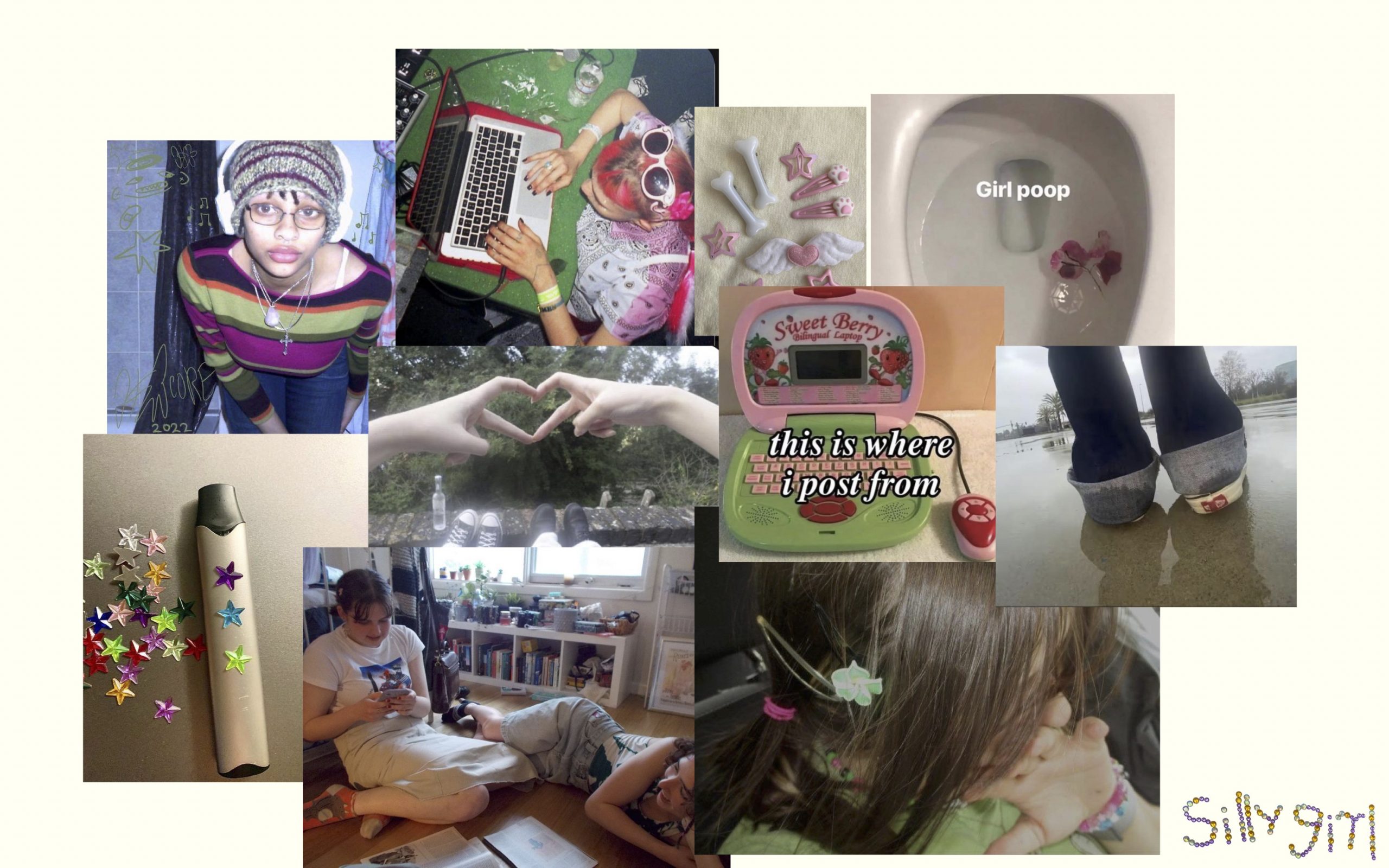Dictionary: Boy: anyone or anything that embodies hegemonic heteronormative and patriarchal ideologies and who loves rationality, logic, and capitalism. Girl: anyone or anything that exists in opposition to hegemonic structures. Boy Tasks: tasks that are stereotypically seen as better performed by men than women, e.g. fixing a car but also bizarre tasks related to male-dominated fields like trading cryptocurrency. Doing Something The Boy Way: doing something in a rational, affect-depleted, boring, normie way. To Sillify: to propose a glitch to the hegemonic modes of doing and being, to perform actions, tasks, and relations in performatively silly ways that oppose neoliberal and patriarchal values. Just Girly Things: this phrase was popularized by the Tumblr page justgirlythings. Here, we define it as things associated with girlhood, especially those that accompanied our coming-of-age years that were done exclusively by girls and ridiculed by boys, e.g. collecting silly bands.
Enlarge

Who is Silly Girl?
2023 was crowned the year of the girl by pretty much every online magazine there is. The post-Barbie movie cultural landscape was oversaturated with pinks, bows, and girl trends. Yet, girls turning to the internet to express themselves is nothing new. Indeed, digital girlhood has been crafting online personas from the get-go. There was the Sad Girl who coped with her sadness through means of Tumblr moodboards or listening to Lana Del Rey. We also saw the rise and fall of the Girlboss, who stormed the web with her CEO mentality and hustle culture grindset. Then came the Femcel who was toxic, sexy, and her online presence was boys’ worst nightmare. What we have been witnessing this year, besides the inundation of girl trends spreading all over social media, with TikTok at the forefront, has been the rise of a new digital girl: the Silly Girl.
Silly Girl takes inspiration from her digital girl predecessors, but she is unique in her quirkiness. From her bedroom (the girl online kingdom), Silly Girl indulges in her delusional thinking, doom-scrolling, posting on her socials, and reading Twilight fanfiction as well as quirky feminist theory. She bedazzles her vape and hits the googoo zaza bong. Silly Girl mansplains astrology. She probably has an Instagram meme account or at least an account dedicated solely to shitposting. Silly Girl eats girl dinner, does girl math, romanticizes her life, and laughs at boys who think about the Roman Empire.

Her style is eccentric, with mismatched socks, striped sweaters, and her hair is a never-ending art project. She likes her bows and pinks but she also wears dirty Converse and baggy t-shirts. Her brother told her his new groundbreaking philosophical take, but she had this thought when she was 12. She likes to be chronically online; tweeting, blogging, and watching Sofia Coppola movies. If she has a job, it's a lazy girl job and she certainly does not fuck with the hustle or the grind. And she will lollygag. She is fully capable of living a “proper” adult life, but she chooses not to. After all, she is just a girl. Even though the Silly Girl likes to feign innocence, she should not be mistaken for being incapable or clueless. She certainly is ‘in the know’. She probably knows more than you do. She’s just plotting and trolling, practising her tomfoolery.
Think Doja Cat with her unserious online presence like trolling her fans, trashposting on Insta, or always being unfiltered. Refusing to be a perfect, well-marketed music star, she prefers to be weird, and sometimes totally unhinged. She may take it a step or two too far, but the point is that you can’t, and in fact, should never, take her seriously. Or think Björk with her unique style and overall whimsiness. When called on stage to collect a music award Björk simply said “I am grateful grapefruit” and her husband is a cat, the only man she can trust. Another example is @chloe.longname on TikTok who, with her satirical and outlandish rants encapsulates the Silly Girl perspective.
There is a lot of aesthetic nostalgia from the early to mid-2000s in the way the Silly Girl visually and digitally expresses herself. Her style, with pink and blue tights, glitter, stars, and colourful striped things, makes many references to an indie sleaze aesthetic. Perhaps she engages in a throwback to the early 2010s because that is roughly when she experienced her coming of age IRL. She craves to reimagine her girlhood. She loves Hello Kitty, hair clips, bows, and ribbons, all quintessential girlhood signifiers. This is where she posts from and on the internet she is forever 13.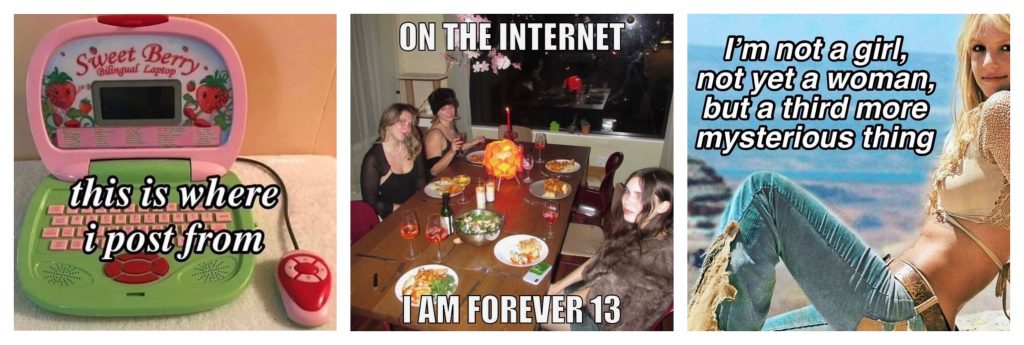 She has re-embraced her youth and all of the cute, pink, expressive, and childlike sense of wonder that this entails. Being a girl is not lame anymore and her interests can never be “too girly”. She is unapologetically indulging in an essentialist girlhood, yet, there is a level of playfulness and performativity here. She brings a goofiness, or dare we say, a silliness, to the table.
She has re-embraced her youth and all of the cute, pink, expressive, and childlike sense of wonder that this entails. Being a girl is not lame anymore and her interests can never be “too girly”. She is unapologetically indulging in an essentialist girlhood, yet, there is a level of playfulness and performativity here. She brings a goofiness, or dare we say, a silliness, to the table.
Theorizing Silliness
Dictionaries define silliness as the quality of lacking good/common sense; foolishness, absurdity, ridiculousness, or irrationality, or being playfully lighthearted and amusing. Further, memes about being silly comprise a broader online category with related catchphrases such as “Tis a Silly Place” circling over ranging social media. The silliness practised by the Silly Girl is embedded in these definitions, but she manages to reframe it a little. She makes it her own. In The Ambiguity of Play, Brian Sutton-Smith theorizes different rhetorics of play. He brings forward an analysis of the historical trickster figure and emphasizes how they “enacted playful protest against the orders of the ordained world”. Sutton-Smith brings our attention to how the trickster occupies a dialectical position within culture; she is simultaneously “the good and the bad, the sobriety and the insobriety, the body conventional and the body uncontrollable”. Enid Welsford, in The Fool, writes:
In The Ambiguity of Play, Brian Sutton-Smith theorizes different rhetorics of play. He brings forward an analysis of the historical trickster figure and emphasizes how they “enacted playful protest against the orders of the ordained world”. Sutton-Smith brings our attention to how the trickster occupies a dialectical position within culture; she is simultaneously “the good and the bad, the sobriety and the insobriety, the body conventional and the body uncontrollable”. Enid Welsford, in The Fool, writes:
For the genius of the fool is manifested by his power of deluding us into the belief that he can draw the sting of pain; by his power of surrounding us with an atmosphere of make-believe, in which nothing is serious, nothing is solid, nothing has abiding consequences. Under the dissolvent influence of his personality, the iron network of physical, social, and moral law, which enmeshes us from the cradle to the grave, seems —for the moment—- negligible as a web of gossamer.
In these theorizations, the Fool is shown to transcend structures of power as long as she is at play. In that sense, this frivolity has “the power to make players feel that they can transcend reality and indeed mortality”. The Silly Girl similarly evokes her silliness. Her online trolling and tomfoolery allow for disengagement of the outside world and the rules that dominate it. Silly Girl often finds herself in a gloomy reality, playing the game that many generations of girls played before her but have never won. She is sick of it. So instead of playing by the real-life-rulebook, she chooses to disengage and play the fool, and as long as she’s performing this role she cannot lose. The Silly Girl thus utilizes silliness as her way of engaging and disengaging from the world. Her silliness takes the shape of an “ignorance is bliss” kind of approach and manifests itself through her unserious attitude that celebrates doing something in a dumb and illogical way. After all, it is easier to do something in a dumb way and laugh about it than get sad or angry. The silly girl, instead of asking for help or mastering the “proper” way, chooses to come up with her silly little ways that may look bizarre to you (boys) but work perfectly fine for us (silly girls). A lot of these tasks we’re referring to here are boy tasks (see dictionary). Trying to do them the boy way (see dictionary) was Girlboss’s thing, but she failed and ended up selling her soul to the hustle. Silly girl refuses these modes of operating.
The Silly Girl thus utilizes silliness as her way of engaging and disengaging from the world. Her silliness takes the shape of an “ignorance is bliss” kind of approach and manifests itself through her unserious attitude that celebrates doing something in a dumb and illogical way. After all, it is easier to do something in a dumb way and laugh about it than get sad or angry. The silly girl, instead of asking for help or mastering the “proper” way, chooses to come up with her silly little ways that may look bizarre to you (boys) but work perfectly fine for us (silly girls). A lot of these tasks we’re referring to here are boy tasks (see dictionary). Trying to do them the boy way (see dictionary) was Girlboss’s thing, but she failed and ended up selling her soul to the hustle. Silly girl refuses these modes of operating.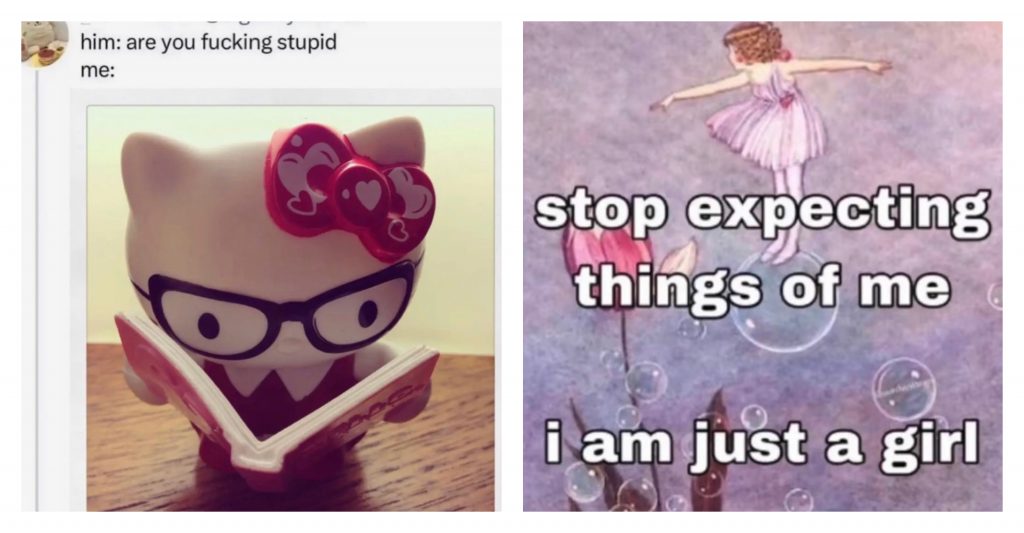 The I'm Just a Girl slogan stormed the web in 2023. It quickly spread to mainstream platforms with all types of girls everywhere sharing their I'm just a girl moments. For example, choosing to fix the hole in their car by sticking a pink bandaid on it, or memes using the slogan religiously. The hashtag #imjustagirl also appears under many confession-style TikToks where girls share their thoughts or questions they have about society. It's encapsulated well in Madeline Argy’s viral video where you can see her crying while stating the question: “What the fuck do DJs actually do?”. This reflects the mentality well: the silly girl is sick of pretending to understand the silly little boy tasks. Instead, through voicing her confusion she exposes their absurdity. Silly Girl does not understand NFTs and she is proud to say it.
The I'm Just a Girl slogan stormed the web in 2023. It quickly spread to mainstream platforms with all types of girls everywhere sharing their I'm just a girl moments. For example, choosing to fix the hole in their car by sticking a pink bandaid on it, or memes using the slogan religiously. The hashtag #imjustagirl also appears under many confession-style TikToks where girls share their thoughts or questions they have about society. It's encapsulated well in Madeline Argy’s viral video where you can see her crying while stating the question: “What the fuck do DJs actually do?”. This reflects the mentality well: the silly girl is sick of pretending to understand the silly little boy tasks. Instead, through voicing her confusion she exposes their absurdity. Silly Girl does not understand NFTs and she is proud to say it. Further, this confusion cannot be read as a passive cluelessness but rather as a potent mode of disengaging from boy tasks and their hegemony. If she wanted to she could grasp all these concepts but she prefers to troll them to expose their dumbness. She refuses to use the master’s tools to dismantle the master’s house. Instead, she disturbs their smooth and ingrained nature and sillifies them. This mode of silliness is thereby drawn to be exclusively for girls (see dictionary), boys (see dictionary) are kindly asked to leave the room.
Further, this confusion cannot be read as a passive cluelessness but rather as a potent mode of disengaging from boy tasks and their hegemony. If she wanted to she could grasp all these concepts but she prefers to troll them to expose their dumbness. She refuses to use the master’s tools to dismantle the master’s house. Instead, she disturbs their smooth and ingrained nature and sillifies them. This mode of silliness is thereby drawn to be exclusively for girls (see dictionary), boys (see dictionary) are kindly asked to leave the room.
I’m Literally Just a Girl
As she memetically expresses herself, the Silly Girl and her silliness often play on the aesthetic quality of cuteness. In exploring cuteness in her book Our Aesthetic Categories: Zany, Cute, Interesting, Sianne Ngai describes cute objects as being soft, rounded, blob-like, groggy, small, and associated with a sense of helplessness and vulnerability. Ngai additionally notes that such qualities of cuteness are associated with what is deemed infantile as well as feminine. The memes where random objects are girlified through the addition of a pink bow are quite explicit in this function. In harnessing the cuteness of the girly symbol of the bow, an image of a coquette chicken nugget channels the endearing powerlessness of girlhood.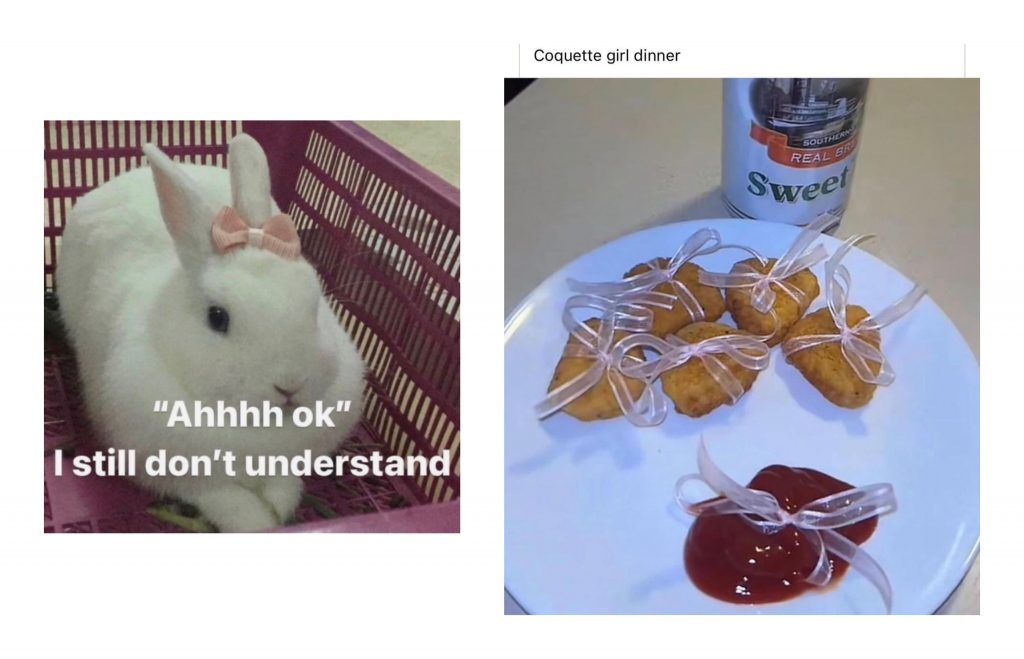 While such implications elicit essentialist understandings of what being a girl is, the use of such cuteness also works to rupture these assumptions. Ngai explains that “in its exaggerated passivity and vulnerability, the cute object is as often intended to excite a consumer’s sadistic desires for mastery and control as much as his or her desire to cuddle.” Thus, while non-threatening, plushy objects invite us to want to lovingly engage with them and snuggle or even vigorously squeeze them, such impulses unveil an underlying belief that the cute object is inferior and subject to domination. Through this Ngai is theorizing the technology of cuteness as a subversive category which functions to expose societal connotations of what cuteness infers. The Silly Girl uses cuteness precisely in this way. She sprinkles cuteness with heavy notes of mimicry: she is so cute that it hurts. She is deploying it to expose the patriarchal sadistic desires that are transposed onto the things that society deems cute.
While such implications elicit essentialist understandings of what being a girl is, the use of such cuteness also works to rupture these assumptions. Ngai explains that “in its exaggerated passivity and vulnerability, the cute object is as often intended to excite a consumer’s sadistic desires for mastery and control as much as his or her desire to cuddle.” Thus, while non-threatening, plushy objects invite us to want to lovingly engage with them and snuggle or even vigorously squeeze them, such impulses unveil an underlying belief that the cute object is inferior and subject to domination. Through this Ngai is theorizing the technology of cuteness as a subversive category which functions to expose societal connotations of what cuteness infers. The Silly Girl uses cuteness precisely in this way. She sprinkles cuteness with heavy notes of mimicry: she is so cute that it hurts. She is deploying it to expose the patriarchal sadistic desires that are transposed onto the things that society deems cute.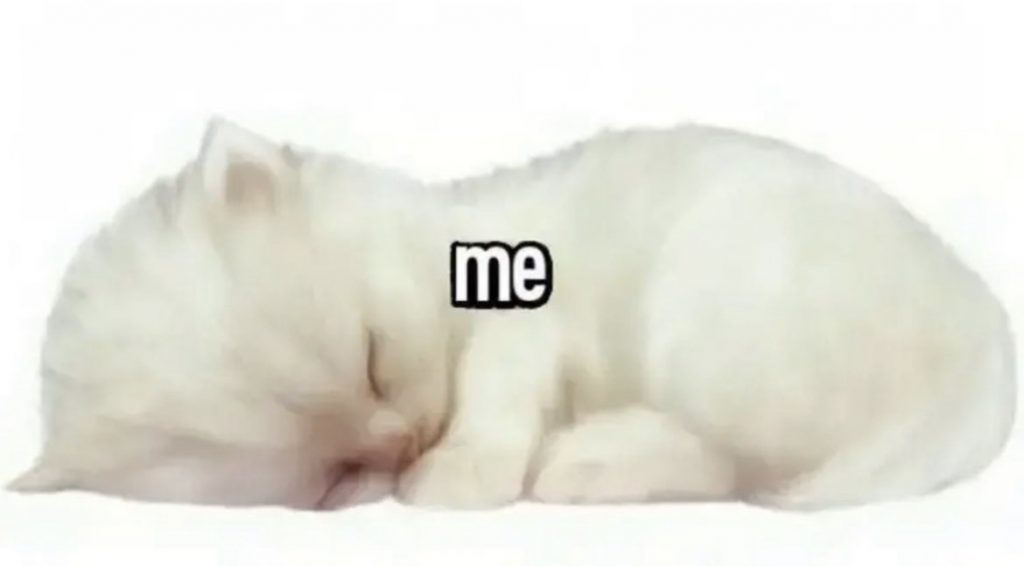 Beyond the guise of docility, Silly Girl expresses her cuteness and girliness in a tongue-in-cheek way. Sure, the Silly Girl can be cute and she responds to what Ngai theorizes, however, she is not just cute, she is silly. Her silliness adds the performative aspect where by ‘acting a fool’ she sillifies these essentialist modes of thinking.
Beyond the guise of docility, Silly Girl expresses her cuteness and girliness in a tongue-in-cheek way. Sure, the Silly Girl can be cute and she responds to what Ngai theorizes, however, she is not just cute, she is silly. Her silliness adds the performative aspect where by ‘acting a fool’ she sillifies these essentialist modes of thinking.
In exploring how the Silly Girl ruptures societal assumptions through her digital presence, it’s helpful to understand how Legacy Russell imagines glitched bodies in her book Glitch Feminism. Glitched bodies are defined as those that do not align with the dominant convention of white cisgender heteronormativity. Understanding the glitch as an error, Russell describes the function of glitched bodies as a failure that “prompts the violent socio-cultural machine to hiccup, sigh, shudder, buffer.” Thus, glitched bodies, in their nonperformance of normative identity, expose the glitch, the defect, in the white, heteronormative, patriarchal matrix. The girl (read dictionary definition), as a glitched body, is proof that this system is flawed and the Silly Girl expresses this glitch visibly through her exaggerated and silly use of cuteness. Through her sillification of cuteness, she performs the ridiculousness of patriarchy.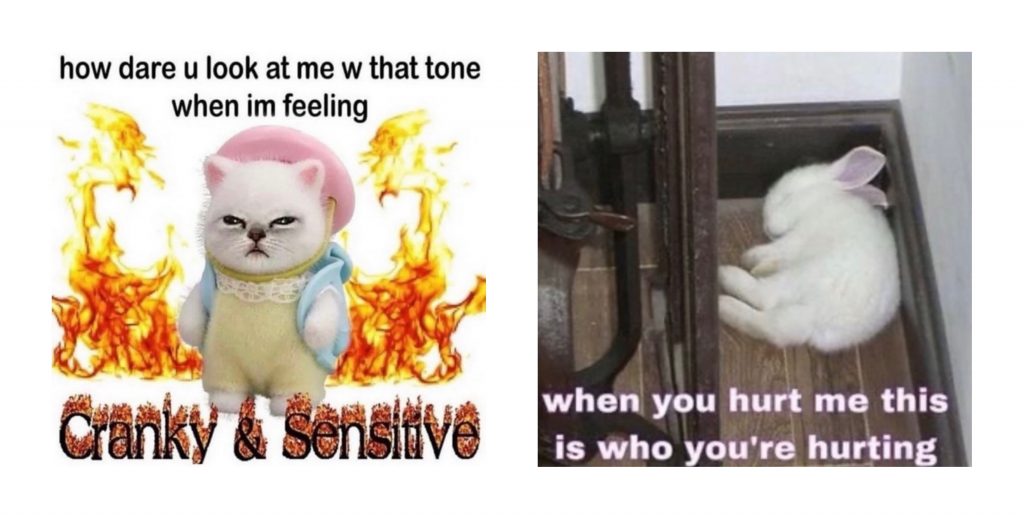 In playing on cute imagery, you’ve probably seen girls pretending to be cute animals online with captions like “When you hurt me, this is who you’re hurting” or “This is me if you even care.” As girls express themselves through images of fluffy bunnies and sleepy, or rather, “eepy”, kittens, they further draw this connection between femininity and vulnerability and evoke what Alex Quicho describes as “going prey mode”. Quicho explains that this radical acceptance of bottom-feeder status allows for a “tactical passivity” in which girls employ an acceptance of powerlessness in this patriarchal system to then comfortably indulge in the bliss of being pretty, helpless, and harmless. Silly Girl loves to “go prey mode”, she delights in reducing herself to a small passive animal. She learned from the weaponized incompetence of her boyfriends and uses her own tactical passivity to essentially reap the benefits of patriarchal assumptions of her weakness and vulnerability. If she's so incapable, if she's so clueless, then we should really just give her a break already.
In playing on cute imagery, you’ve probably seen girls pretending to be cute animals online with captions like “When you hurt me, this is who you’re hurting” or “This is me if you even care.” As girls express themselves through images of fluffy bunnies and sleepy, or rather, “eepy”, kittens, they further draw this connection between femininity and vulnerability and evoke what Alex Quicho describes as “going prey mode”. Quicho explains that this radical acceptance of bottom-feeder status allows for a “tactical passivity” in which girls employ an acceptance of powerlessness in this patriarchal system to then comfortably indulge in the bliss of being pretty, helpless, and harmless. Silly Girl loves to “go prey mode”, she delights in reducing herself to a small passive animal. She learned from the weaponized incompetence of her boyfriends and uses her own tactical passivity to essentially reap the benefits of patriarchal assumptions of her weakness and vulnerability. If she's so incapable, if she's so clueless, then we should really just give her a break already. The Silly Girl loves to play on this dumbness aspect of being cute, again practising her ignorance is bliss attitude. This is best encapsulated by the ‘girls getting drafted for war’ TikToks. These appeared after a Deepfake video of United States President Joe Biden came out where he was saying that he would reinstate the military draft and that women would be included. Essentially, the TikTok memes girlify, as well as sillify (see dictionary), the military experience (see videos). Being in the army is given a pink, prissy flair and this works to co-opt these essentialist narratives of women to get out of hypothetically getting drafted. Silly Girl does not want to go to war. Silly Girls think war is silly and so, through these memes, they sillify the whole ordeal in general. War is a boy thing. Boys like the military. Silly Girls are not down with the military-industrial complex and the violent regimes of the state.
The Silly Girl loves to play on this dumbness aspect of being cute, again practising her ignorance is bliss attitude. This is best encapsulated by the ‘girls getting drafted for war’ TikToks. These appeared after a Deepfake video of United States President Joe Biden came out where he was saying that he would reinstate the military draft and that women would be included. Essentially, the TikTok memes girlify, as well as sillify (see dictionary), the military experience (see videos). Being in the army is given a pink, prissy flair and this works to co-opt these essentialist narratives of women to get out of hypothetically getting drafted. Silly Girl does not want to go to war. Silly Girls think war is silly and so, through these memes, they sillify the whole ordeal in general. War is a boy thing. Boys like the military. Silly Girls are not down with the military-industrial complex and the violent regimes of the state.
Furthermore, Silly Girl milks this assumption that she is incompetent, to lower expectations, and get others to cut her some slack when she turns a little devious. She’s too cute to understand, so how can she really be held accountable for her actions? This is a way in which the Silly Girl revises the Femcel's manipulation. The Femcel’s goal is to ruin boys’ lives, but the Silly Girl just wants to humiliate and taunt them a little. The Femcel takes full accountability for her actions and prides herself in being the anti-hero, while the Silly Girl didn’t mean to, oopsie. She luxuriates in playing the fool. Sorry if she did something that will irreversibly mess up your life, but she’s literally just a girl <3.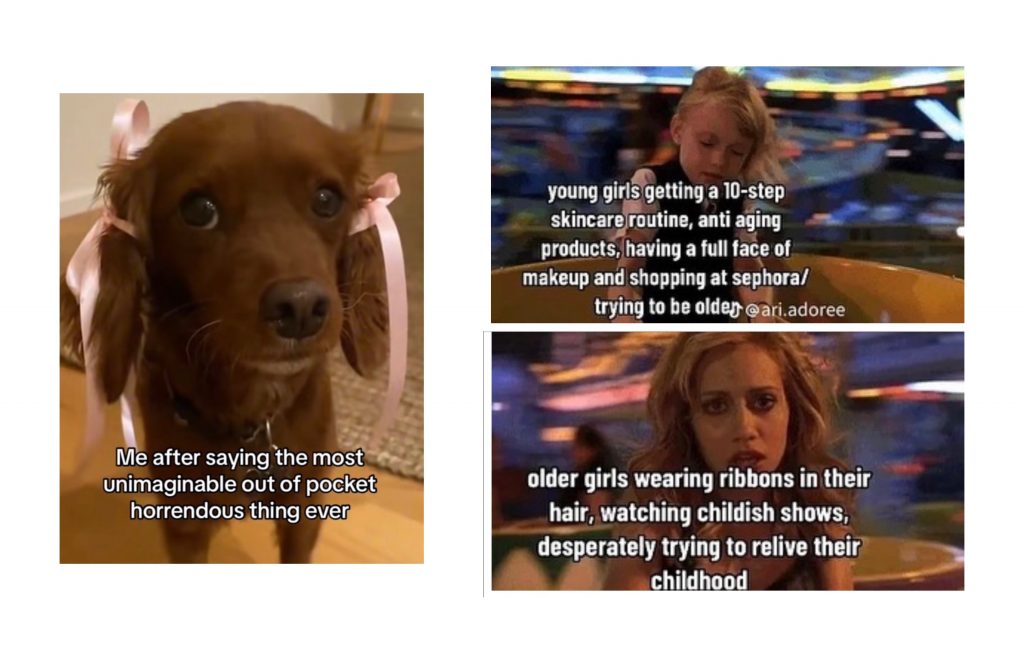 Tiqqun theorized the figure of the Young Girl who is the product of a society that loves pretty young girls with a “morally pink complexion.” She is a symptom of a culture that turned adolescence into a commodity aligned with consumerist demands. The Silly Girl on some level reflects the infantilized image of a girl in the sense that she romanticizes her girlhood. But, while the Young Girl “exists only in proportion to the desire that THEY have for her and knows herself only by what THEY say she is”, the Silly Girl rebels against internalizing the external gaze. She is aware that the essentialist ideas she plays with have a history of violence. Yet her play is strategic. The Silly Girl ingests patriarchal assumptions and digests them only to exert them as her own. After all, no one can hurt her by infantilizing or simplifying who she is, when she already does that herself.
Tiqqun theorized the figure of the Young Girl who is the product of a society that loves pretty young girls with a “morally pink complexion.” She is a symptom of a culture that turned adolescence into a commodity aligned with consumerist demands. The Silly Girl on some level reflects the infantilized image of a girl in the sense that she romanticizes her girlhood. But, while the Young Girl “exists only in proportion to the desire that THEY have for her and knows herself only by what THEY say she is”, the Silly Girl rebels against internalizing the external gaze. She is aware that the essentialist ideas she plays with have a history of violence. Yet her play is strategic. The Silly Girl ingests patriarchal assumptions and digests them only to exert them as her own. After all, no one can hurt her by infantilizing or simplifying who she is, when she already does that herself.
Silly Girl as Psychic Armor
Earlier internet days provided people the opportunity to be whoever they wanted online. Today, with tracking IDs, Cookies, and the centralized platform system, your online privacy and agency look way more gloomy. Nevertheless, certain online communities manage to maintain that Teh Internet is Not Serious Business. Daniël de Zeeuw and Marc Tuters in Teh Internet Is Serious Business discuss Deep Vernacular Web (DVW) movements such as 4chan, exposing how their “subcultural practices (...) are rooted in the cyber-separationist ethos of early web culture, which imagined the internet as a virtual space of play detached and separate from “real life”’. They argue that this approach, which favors identity play, masks, and anonymity over identity authentication and profiles that reflect our IRL selves, can “provide a counter-hegemonic space”. The DVW is more often than not a dangerous vessel for spreading alt-right ideology, but their online frivolity can teach us a lesson or two. Indeed, the DVW visualizes that digital spaces can still allow for a level of playfulness, and this mode of being has potent political potential.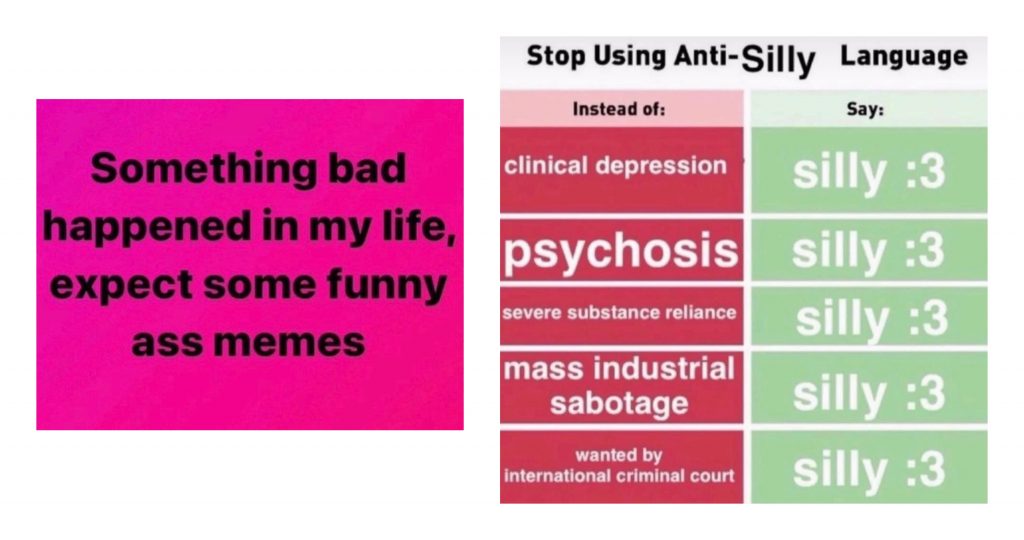 Digital girlhood takes the shape of a performance embedded in a similar logic. For years now, girls have treated the internet as a space for refusal of the male-dominated values that rule their Away from Keyboard (AFK) lives. The Sad Girls have radicalized and politicized their sadness by posting crying pics on Tumblr. The Femcels used social media to manipulate boys and express their rage. Silly Girls respond to similar issues through means of trolling and sillifying. The internet thereby allows for practising a strategic (dis)identification with a wide array of ways to be a girl online.
Digital girlhood takes the shape of a performance embedded in a similar logic. For years now, girls have treated the internet as a space for refusal of the male-dominated values that rule their Away from Keyboard (AFK) lives. The Sad Girls have radicalized and politicized their sadness by posting crying pics on Tumblr. The Femcels used social media to manipulate boys and express their rage. Silly Girls respond to similar issues through means of trolling and sillifying. The internet thereby allows for practising a strategic (dis)identification with a wide array of ways to be a girl online. Something horrible in my life happened, expect some funny ass memes is a quintessential reflection of Silly Girl’s onlineness. Silly Girl’s web behaviour becomes her psychic armor. Like the Sad Girl, Girlboss, and the Femcel, the Silly Girl is troubled. She is sad, she is desperate, she is angry, she may be mentally ill. But online, these problems don’t really matter. After all, the internet is just a support group for girls who are never normal about anything ever.
Something horrible in my life happened, expect some funny ass memes is a quintessential reflection of Silly Girl’s onlineness. Silly Girl’s web behaviour becomes her psychic armor. Like the Sad Girl, Girlboss, and the Femcel, the Silly Girl is troubled. She is sad, she is desperate, she is angry, she may be mentally ill. But online, these problems don’t really matter. After all, the internet is just a support group for girls who are never normal about anything ever.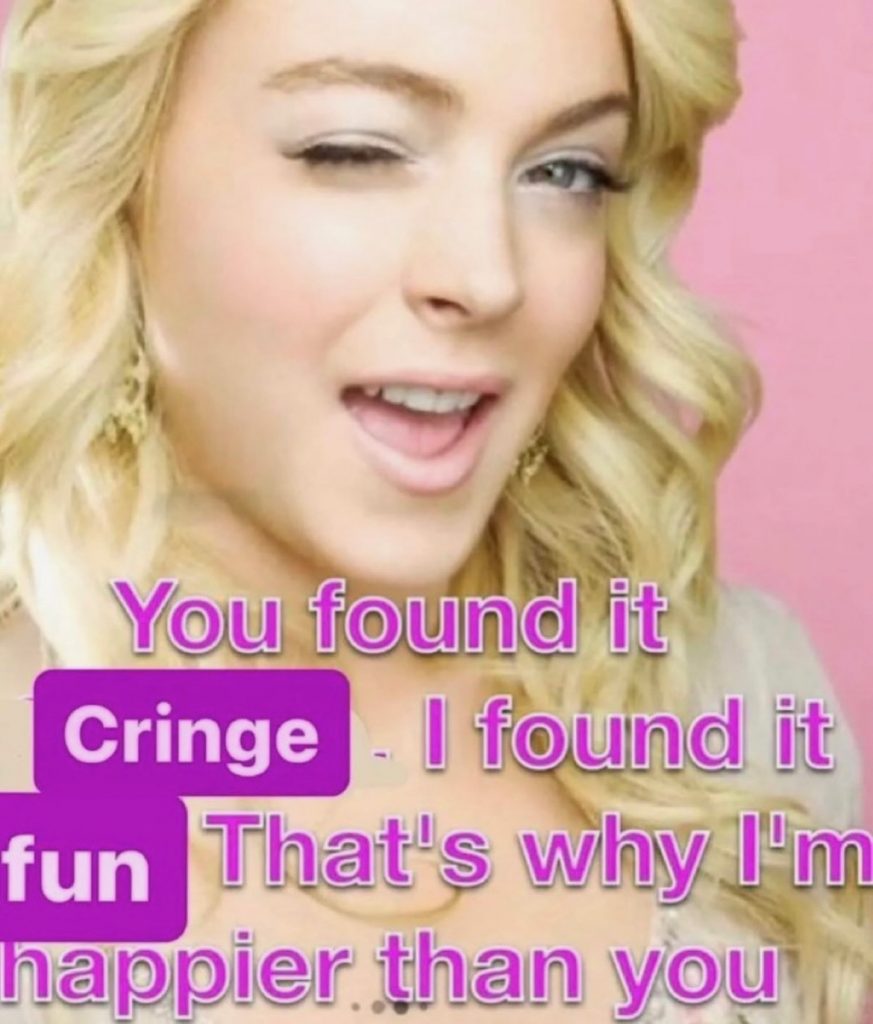 The popular belief that girls mature faster exposes a complex framework that elicits societal pressure for girls to become women quite fast. It is much less frowned upon for grown men to still indulge in their coming-of-age obsessions such as fangirling over a football player, than it is for women to enjoy typically girly things. Nadira Begum puts this well;
The popular belief that girls mature faster exposes a complex framework that elicits societal pressure for girls to become women quite fast. It is much less frowned upon for grown men to still indulge in their coming-of-age obsessions such as fangirling over a football player, than it is for women to enjoy typically girly things. Nadira Begum puts this well;
Squealing over an actor you fancy is embarrassing, and crying when your favourite band breaks up is childish. If a piece of media incites strong emotion out of a largely teen girl fanbase, as Twilight did, then it is not to be taken seriously. Dismissing anything associated with young women is an age-old misogynistic practice with the express intent to silence young girls.
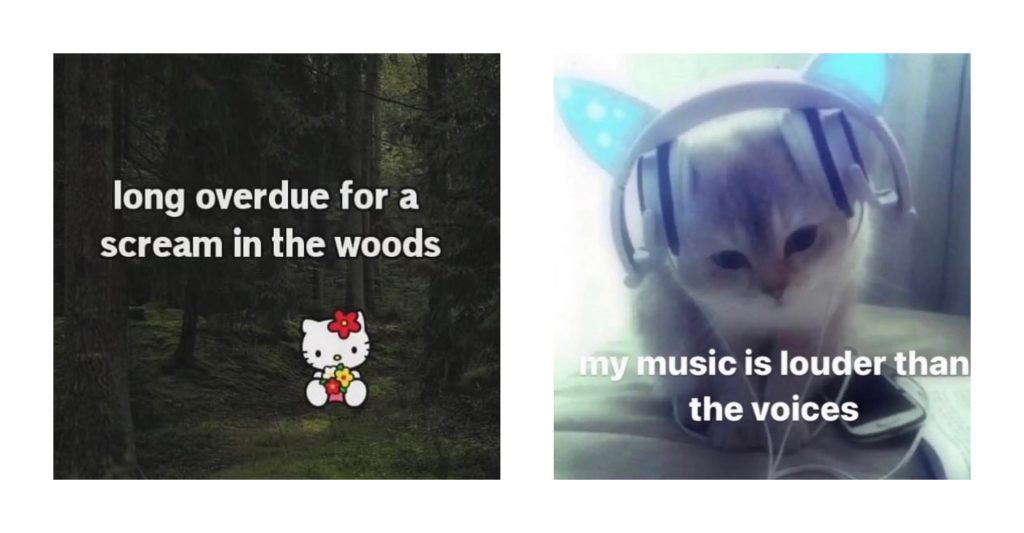 The Silly Girl can thus also act as a mode of reclaiming girlhood and rebelling against all the sadness we felt when we weren’t allowed to do just girly things (see dictionary). Beyond that, being a teen girl entails a level of surveillance that leaves little space for real innocence and is often accompanied by fast sexualization. This situation gets especially amplified under an intersection of inequalities. Legacy Russel recalls her coming-of-age years in the following way; “I was a young body: Black, female-identifying, femme, queer. There was no pressure pause, no reprieve; the world around me never let me forget these identifiers. Yet online I could be whatever I wanted.” We turn to the internet to disassociate from our troubles. To cosplay a little.
The Silly Girl can thus also act as a mode of reclaiming girlhood and rebelling against all the sadness we felt when we weren’t allowed to do just girly things (see dictionary). Beyond that, being a teen girl entails a level of surveillance that leaves little space for real innocence and is often accompanied by fast sexualization. This situation gets especially amplified under an intersection of inequalities. Legacy Russel recalls her coming-of-age years in the following way; “I was a young body: Black, female-identifying, femme, queer. There was no pressure pause, no reprieve; the world around me never let me forget these identifiers. Yet online I could be whatever I wanted.” We turn to the internet to disassociate from our troubles. To cosplay a little.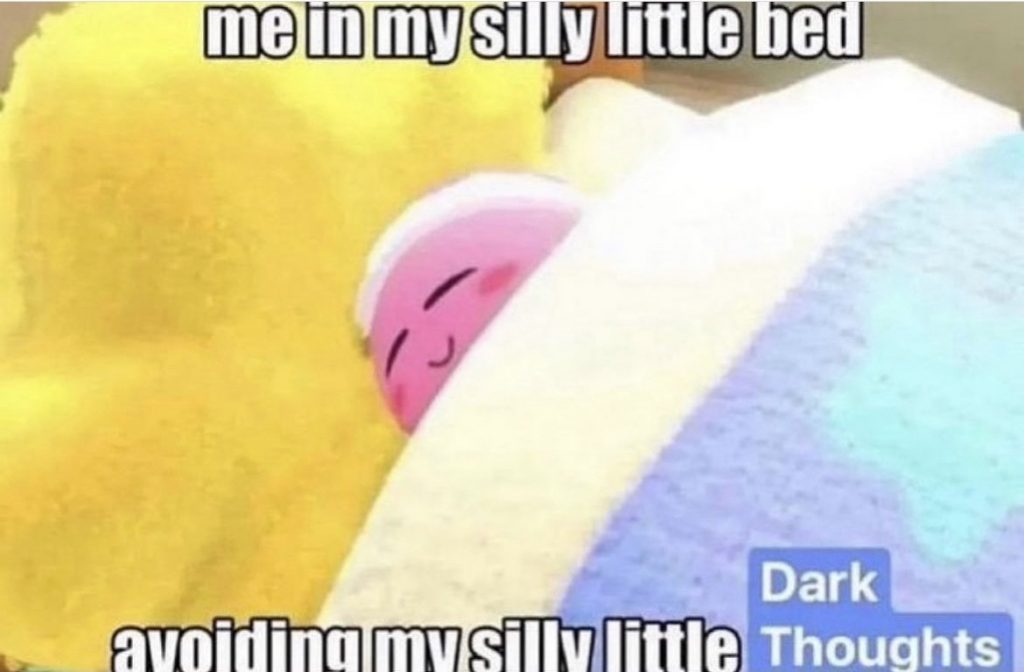 Silly girl at her essence is politically aware, but she chooses to ignore that and have fun, be ironic, and be “baby”. There is a tremendous privilege in this chosen ignorance. Not everyone can just decide to be ignorant if they are tired of engaging with society's issues. The girlhood experience that the Silly Girl taps into, the one of ignorance is bliss and a happy carefree childhood, is one that channels the white middle-class experience. Therefore, Silly Girl’s digital persona is white, middle-class, and cis-coded. However, this digital persona can be used as psychic armour and a coping mechanism to escape AFK realities. The people using Silly Girl as their virtual avatar don’t need to necessarily relate to this blissful girlhood experience, they can simply use Silly Girl as their digital roleplay. In this way, the Silly Girl allows an experience of privilege where she can decide whether to tap in or tap out of life issues. A digital persona such as Silly Girl, can therefore become a psychic armour that we put on whenever needed. Why pay $200 for a therapist when you have Silly Girl who is always there and will protect you?
Silly girl at her essence is politically aware, but she chooses to ignore that and have fun, be ironic, and be “baby”. There is a tremendous privilege in this chosen ignorance. Not everyone can just decide to be ignorant if they are tired of engaging with society's issues. The girlhood experience that the Silly Girl taps into, the one of ignorance is bliss and a happy carefree childhood, is one that channels the white middle-class experience. Therefore, Silly Girl’s digital persona is white, middle-class, and cis-coded. However, this digital persona can be used as psychic armour and a coping mechanism to escape AFK realities. The people using Silly Girl as their virtual avatar don’t need to necessarily relate to this blissful girlhood experience, they can simply use Silly Girl as their digital roleplay. In this way, the Silly Girl allows an experience of privilege where she can decide whether to tap in or tap out of life issues. A digital persona such as Silly Girl, can therefore become a psychic armour that we put on whenever needed. Why pay $200 for a therapist when you have Silly Girl who is always there and will protect you?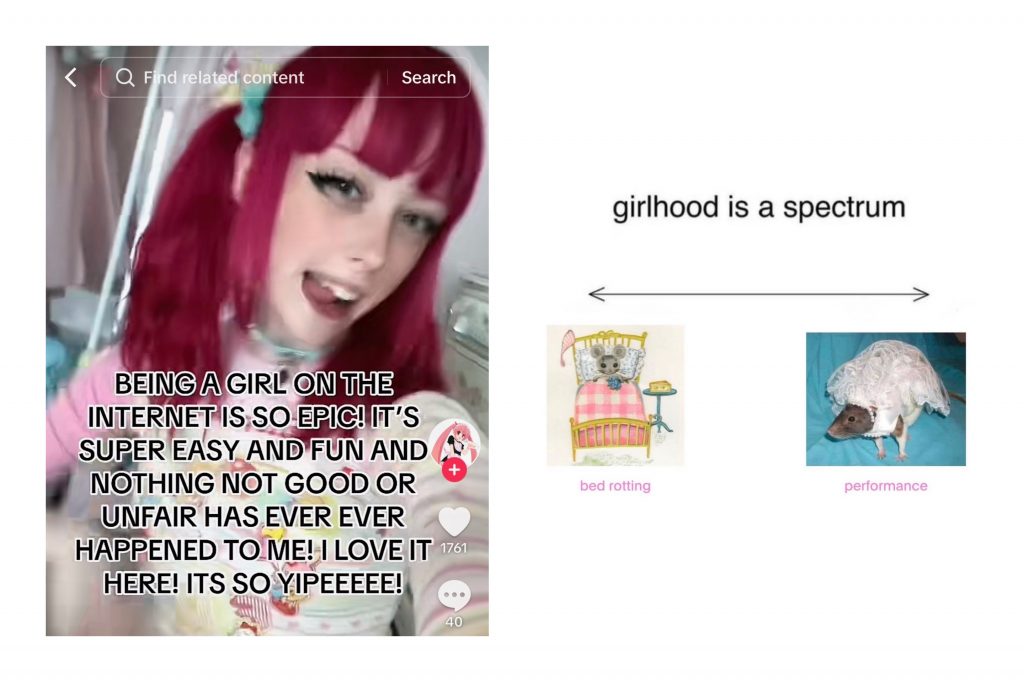 Silly Girl is sad inside, but we cannot equate her emotions with those of the Sad Girl. While Sad Girl indulges in a hardcore aestheticization of her sadness, the Silly Girl ridicules her pain. The Sad Girl cries in public, smokes cigarettes, and politicizes her vulnerability. Sad Girl rotting entails lying in bed all day wallowing in her self-pity and heartbreak. On the other hand, Silly Girl rotting entails lying in bed all day bingeing a series, spending way too much time on the internet, and being too lazy to get up and make a meal more complex than a few crackers and an assortment of candy and chunks of cheese. Both certainly evoke imagery of mental instability but are expressed quite differently. The Silly Girl clowns her emotions and is not pretty when she cries. She roams the web avoiding her silly little dark thoughts, sprinkling heavy satire onto any unfortunate situation. What’s more, her sadness often turns into delusion.
Silly Girl is sad inside, but we cannot equate her emotions with those of the Sad Girl. While Sad Girl indulges in a hardcore aestheticization of her sadness, the Silly Girl ridicules her pain. The Sad Girl cries in public, smokes cigarettes, and politicizes her vulnerability. Sad Girl rotting entails lying in bed all day wallowing in her self-pity and heartbreak. On the other hand, Silly Girl rotting entails lying in bed all day bingeing a series, spending way too much time on the internet, and being too lazy to get up and make a meal more complex than a few crackers and an assortment of candy and chunks of cheese. Both certainly evoke imagery of mental instability but are expressed quite differently. The Silly Girl clowns her emotions and is not pretty when she cries. She roams the web avoiding her silly little dark thoughts, sprinkling heavy satire onto any unfortunate situation. What’s more, her sadness often turns into delusion. Silly Girl is completely Delulu--and she loves it. Being rational is overrated and lame, she leaves that to the boys. When Silly Girls get together, they love to validate each other’s delusions and manifest their realities. I am God’s weakest soldier, I will get his easiest battles (they all repeat about 50 times in a row). Only good things can happen to me! Why participate in the rat race for the best job when she can simply light a candle and hyper-fantasize about getting it in her dreams? She trusts the universe and refuses to enter neoliberal modes of being that always blame the individual. Silly Girl blames the system. Being delusional is then yet another way in which she chooses to troll her struggles. Ironic detachment comes in handy when you’re busy trying to avoid a mental breakdown.
Silly Girl is completely Delulu--and she loves it. Being rational is overrated and lame, she leaves that to the boys. When Silly Girls get together, they love to validate each other’s delusions and manifest their realities. I am God’s weakest soldier, I will get his easiest battles (they all repeat about 50 times in a row). Only good things can happen to me! Why participate in the rat race for the best job when she can simply light a candle and hyper-fantasize about getting it in her dreams? She trusts the universe and refuses to enter neoliberal modes of being that always blame the individual. Silly Girl blames the system. Being delusional is then yet another way in which she chooses to troll her struggles. Ironic detachment comes in handy when you’re busy trying to avoid a mental breakdown.
Anti-Boy
According to Christine H. Tran, “to #girlboss is to pursue neoliberal values of individual choicehood as the primary vector of women’s liberation from market misogyny”. Silly Girl learned important lessons from her digital sister. She refuses to travel down that road again. So instead of trying to enter the system, she tries to disturb it through her taunting online persona. In doing so, she confronts neoliberal values that favour the grind, productivity, rationality, and normcore. Two strategies are key here: hating on the boys, and sillifying money and logic.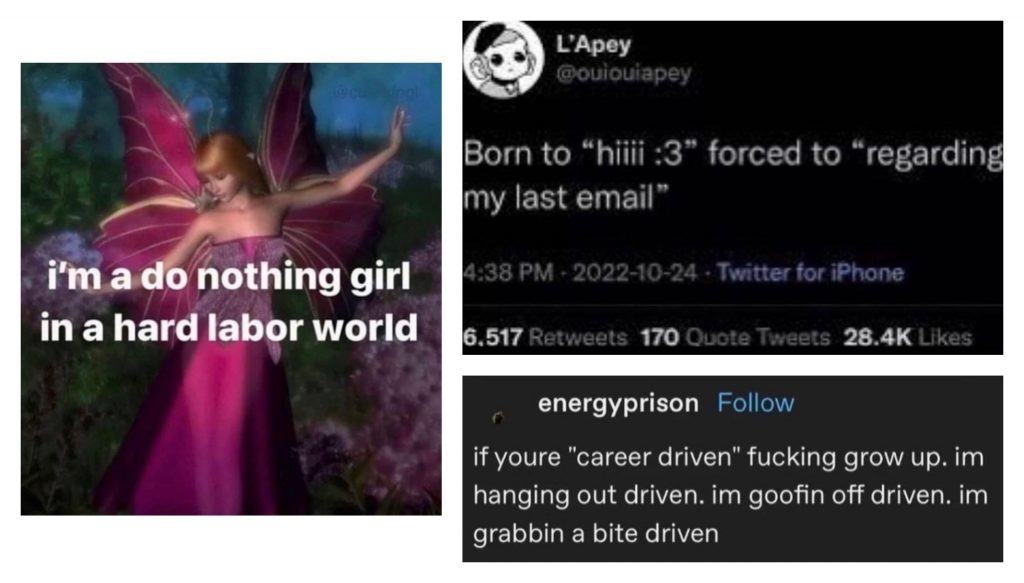 In this world boys symbolize anyone or anything that produces, reflects, or maintains the hegemonic structures based on patriarchy, neoliberalism, and racism. Silly Girl does not like the boys and exists in a cybersphere where they are not welcome. Goodnight to women only, men I wish y'all have nightmares tonight, Silly Girl tweets. If it was up to her, boys would not be allowed on the internet. They already take up too much space IRL. So as you’d expect from a professional troller, Silly Girl uses her socials to make fun of them. Think Roman Empire trend that helped her expose the peculiar nature of the boy brain. Boys think about the Roman Empire a lot because it is a symbol of order, logic, and masculinity - all the things that Silly Girl hates. Thus by laughing at the boys, she is laughing at the entire system, and through that, sillifying it.
In this world boys symbolize anyone or anything that produces, reflects, or maintains the hegemonic structures based on patriarchy, neoliberalism, and racism. Silly Girl does not like the boys and exists in a cybersphere where they are not welcome. Goodnight to women only, men I wish y'all have nightmares tonight, Silly Girl tweets. If it was up to her, boys would not be allowed on the internet. They already take up too much space IRL. So as you’d expect from a professional troller, Silly Girl uses her socials to make fun of them. Think Roman Empire trend that helped her expose the peculiar nature of the boy brain. Boys think about the Roman Empire a lot because it is a symbol of order, logic, and masculinity - all the things that Silly Girl hates. Thus by laughing at the boys, she is laughing at the entire system, and through that, sillifying it.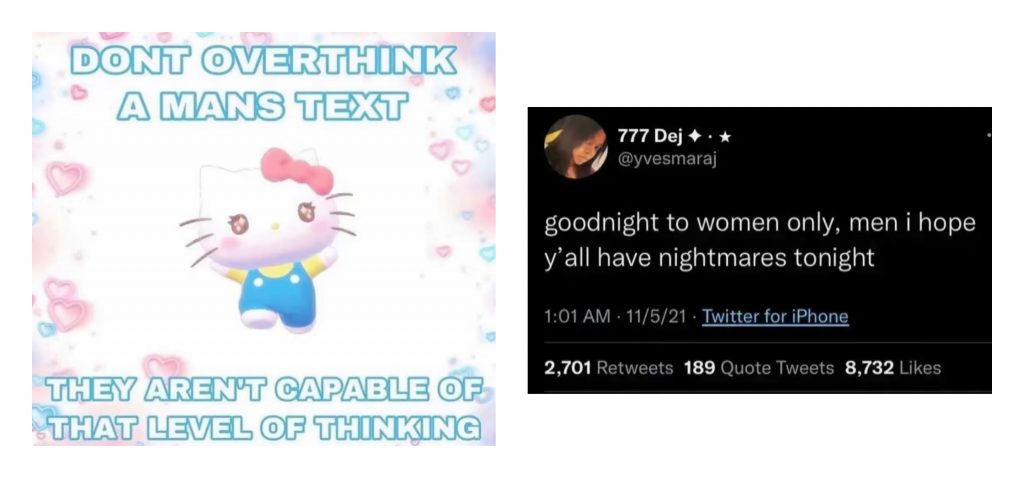 Silly Girl provides a counter-space where logic, rationality, and seriousness are traded in for affect, irony, and quirkiness. The popular trend Girl Math that stormed TikTok resonates here. The videos bring forward girls sharing their stories about how they view money. For example, if you pay in cash, then whatever you bought was free. If you return the $50 dress you bought, you just get a free $50. The flight you’re taking tomorrow is free since you paid for it 3 months ago. While Girl Math can be deemed as nothing more than a shallow joke, we refuse to ignore its political potency. See, what the Silly Girl is doing here she is refusing the seriousness of money. She sillifies all things that neoliberal capitalism holds so dear. We have already seen how Silly Girl shows that the internet is a goofy business and now she is applying this framework to money. It is at this point that all the remaining boy readers clench their fists and run away. No, Silly Girl will not admire your Doge Coin stocks, or validate your Andrew Tate mentality, nor will she shorten her naps to boost her daily productivity, go cry about it. Thus, by hating on the boys, she is hating on notions, of logic, seriousness, and money and thereby glitching the wider system that rules our neoliberal reality.
Silly Girl provides a counter-space where logic, rationality, and seriousness are traded in for affect, irony, and quirkiness. The popular trend Girl Math that stormed TikTok resonates here. The videos bring forward girls sharing their stories about how they view money. For example, if you pay in cash, then whatever you bought was free. If you return the $50 dress you bought, you just get a free $50. The flight you’re taking tomorrow is free since you paid for it 3 months ago. While Girl Math can be deemed as nothing more than a shallow joke, we refuse to ignore its political potency. See, what the Silly Girl is doing here she is refusing the seriousness of money. She sillifies all things that neoliberal capitalism holds so dear. We have already seen how Silly Girl shows that the internet is a goofy business and now she is applying this framework to money. It is at this point that all the remaining boy readers clench their fists and run away. No, Silly Girl will not admire your Doge Coin stocks, or validate your Andrew Tate mentality, nor will she shorten her naps to boost her daily productivity, go cry about it. Thus, by hating on the boys, she is hating on notions, of logic, seriousness, and money and thereby glitching the wider system that rules our neoliberal reality.
Trading Silliness
The bodies of young girls become sites of struggle where many different disciplines compete. And more often than not, money becomes inextricable from these operations. Tiqqun argues that the Young Girl is a “living currency,” which can be applied to many digital girl personas too. The figure of the girl can easily become a commodity. The Girlboss showed us this process; she essentially made girls mainstream. This had some positive impact, opening doors that only boys could use but it also helped turn the girl into a commodity that could be traded. This shows one of many ways that the commodification of girls can take place and hints at an equally huge amount of ambiguous relations and power dynamics it engenders.
What makes this process more complex is that female labour has been confused with a pastime for centuries. Marx already called our attention to how domestic labour is undervalued and indicative of unequal wealth distribution within a household. Further as pointed out by Rachel O’Dwyer “Girls trade on the ambiguous nature of women’s work - care, affect, sex – as well as the invisible nature of women’s money – often coming in the form of gifts, treats, girl dinners, or ‘little somethings”. Thus, both the labour as well as the compensation often float in some uneasy metasphere where hard transfers or cash are not tangible. It seems that the two most prominent options to respond to such an environment are either to commodify yourself or to be commodified. For example, Tiqqun writes that the Young Girl “is the one who has preferred to become a commodity, rather than passively suffer its tyranny.” What about the Silly Girl then?
We all know that capitalism loves taking things that start as subcultural or belonging to specific communities and repackaging them as a mainstream identity that they can reproduce for large profits. The girlhood revival started as a space for girls to reclaim the things that they were made to feel dumb for liking when they were young. It provides an escape, a space to forget about their adult jobs and struggles and instead, go back to the simpler days if even just online. Yet, as is usually the case, brands and marketing campaigns were quick to jump on this bandwagon. Barbie was the highest-grossing film release of 2023, Shein’s online store is full of tops with bows, and Popeye’s launched their limited “girl dinner” meal, signalling that the commercialization process is well on its way.
Nevertheless, Silly Girl is not just the pink girl who eats girl dinner and does girl math. Yes, she does plenty of these things too but don’t forget: she is SILLY. Her silliness adds a level of subversiveness to her maneuvering through the different girl trends. Is it possible that her silliness makes her less commodifiable? It is too early to pose a definitive answer. Still, we believe that the Silly Girl uses her nihilism and political incorrectness so strategically that she may just hold the power to escape being reduced to a marketing stunt. Perhaps what is especially potent about the Silly Girl is that anyone can be her whenever she is needed. Her performative nature makes her harder to define. Thus, while it is possible that like many of her online ancestors, she may just fall into the capitalist clog that will depoliticize her persona, she may also very well withstand these processes. The key is to stay moving and never allow the system to enclose her within a stable identity category that can be reproduced for profit.
Is Everyone in on the Joke?
The ironic online presence of the Silly Girl may also pose certain issues in terms of the reception or impact of her content. Silly Girl’s humour leans in a post-ironic sentiment in the sense that it creates confusion about whether the message is sincere or not. As sarcasm doesn’t always translate through text, not everyone who comes across Silly Girl will understand how to interpret her. Silly Girl may be in on the joke, but there is something to be said concerning the potential risks this sort of content poses when misread by people who are not. Post-irony, through its ambiguous form, can easily avoid any political categorization, thus leaving Silly content both open to depoliticization as well as misinterpretation. While she may be engaging in essentialist roleplay to ridicule patriarchal assumptions, her performance may be taken too literally.
The liberal audience of pink entrepreneurs has catapulted these girl trends into mainstream fame without maintaining the dark humour that underscores Silly content and serves as a safety net from the violence of gender hegemony. On the other hand, her indifference and at times, her political incorrectness, might not be seen as a post-ironic and escapist comedic practice, but instead, might accidentally appeal to the Tradwives and Top G enthusiast 4chan dwellers of the internet. This is best exemplified by the “I don’t dream of labor” TikTok trend which was initially used in memes critiquing capitalism, but was adopted by TradWives as an affirmation of their traditional gender role. The point of the cryptic nature of Silly Girl's content is to not assume everything is serious business and remember that one can never know when Silly Girl is being for real (maybe never). Potentially, in the cases in which her content is read literally, it may serve to further reinforce the structures we claim she is protecting herself from. However, it is important to intervene in these politically contested spaces and, as put by Geert Lovink, “reclaim the power of definition in the fight against right-wing meme hegemony”.

Girlhood as Grief
In the end, Silly Girl is a digital reprieve where one can come to bask in the ironic warmth of a worry-free life. Each of these digital girl personas has served as a hideout from the violence of the socio-cultural matrix. We are left to find any sliver of distraction, of respite, that allows us to be existentially capable of tolerating the crushing reality of existing under the hegemonic neoliberal chokehold. How can 2023 be the “year of the girl” with such an alarming rate of femicides? The underlying struggle and distress of all these digital girls evolve from the same source, yet they express themselves through different coping mechanisms.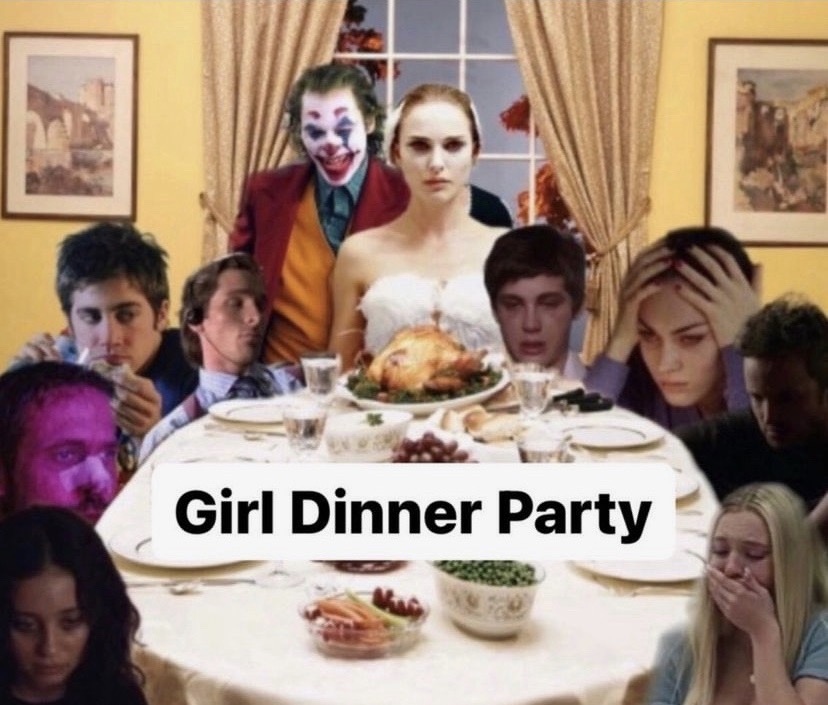 The concept of grief and grieving has famously been reduced to the 5-stages of denial, anger, bargaining, depression, and acceptance. In Grief Worlds: A Study of Emotional Experience, Matthew Ratcliffe explains that while maintaining the notion that grief is a process, this is by no means to suggest that it is linear or reductive. Elizabeth Kübler-Ross and David Kessler, who put forward the 5 stages of grief model in their book On Grief and Grieving: Finding the Meaning of Grief through the Five Stages of Loss, did not do so to fit grief into a neat and digestible formula. Radcliffe proposes an understanding of these stages of grief as helpful for a theoretical conceptualization of the grieving process. This becomes particularly pertinent in understanding how each of these manifestations of grief interrelate both temporally and expressively. Grief is deeply embedded in the girlhood experience—the loss of innocence, of ignorance, of bodily sovereignty. We grieve the blissful, unattainable, and imagined girlhood experience. Some clench this fantasy with their fists before it can peel away, others cannot wait to leave it behind. In either case, girlhood is such an ephemeral state perhaps because it rarely ever fully belongs to us.
The concept of grief and grieving has famously been reduced to the 5-stages of denial, anger, bargaining, depression, and acceptance. In Grief Worlds: A Study of Emotional Experience, Matthew Ratcliffe explains that while maintaining the notion that grief is a process, this is by no means to suggest that it is linear or reductive. Elizabeth Kübler-Ross and David Kessler, who put forward the 5 stages of grief model in their book On Grief and Grieving: Finding the Meaning of Grief through the Five Stages of Loss, did not do so to fit grief into a neat and digestible formula. Radcliffe proposes an understanding of these stages of grief as helpful for a theoretical conceptualization of the grieving process. This becomes particularly pertinent in understanding how each of these manifestations of grief interrelate both temporally and expressively. Grief is deeply embedded in the girlhood experience—the loss of innocence, of ignorance, of bodily sovereignty. We grieve the blissful, unattainable, and imagined girlhood experience. Some clench this fantasy with their fists before it can peel away, others cannot wait to leave it behind. In either case, girlhood is such an ephemeral state perhaps because it rarely ever fully belongs to us.
Our digital escape through girl identities is an attempt to reclaim what has been lost. Through her lonesome tears, the Sad Girl expresses herself through depression. In attempting to assert herself within the capitalist order, the Girlboss tries bargaining for her freedom. By going for scorched earth strategy the Femcel personifies anger. The Silly Girl, on the other hand, with her performative ignorance and comedic mask, hides within the comfort of denial. While each virtual girl persona embodies a certain emotive manifestation of the grieving process, there is no progression in this ‘process’. There is no linear framework for this grief. It is simply a fact of girlhood. After being so inconsolably sad, pitifully pleading, and dreadfully enraged, she’s tired, she just wants to put her feet up and act a little silly and she deserves a little treat.
After being so inconsolably sad, pitifully pleading, and dreadfully enraged, she’s tired, she just wants to put her feet up and act a little silly and she deserves a little treat.

Reference List
Banet-Weiser, Sarah, and Kate M. Miltner. “#masculinitysofragile: Culture, Structure, and Networked Misogyny.” Feminist Media Studies 16, no. 1 (2015): 171–74. https://doi.org/10.1080/14680777.2016.1120490.
Begum, Nadira. “So the Lion Fell in Love with the Lamb (Again): Reclaiming Girlhood via Nostalgia.” Polyester, September 25, 2023. https://www.polyesterzine.com/features/so-the-lion-fell-in-love-with-the-lamb-againre claiming-girlhood-via-nostalgia.
“Femicide CSW 2023.” United Nations: Office on Drugs and Crime, March 9, 2023. https://www.unodc.org/unodc/en/newyork/events/femicide-csw-2023.html.
Kübler-Ross, Elisabeth, and David Kessler. On Grief and Grieving: Finding the Meaning of Grief through the Five Stages of Loss. New York ; London, 2005.
Ngai, Sianne. “The cuteness of the avant‐garde.” Critical Inquiry, vol. 31, no. 4, 2005, pp. 811–847, https://doi.org/10.1086/444516.
O’Dwyer, Rachel. “The Girl Is a Living Currency - How Womanhood Has Always Been Its Own Economy.” Polyester, October 10, 2023. https://www.polyesterzine.com/features/the-girl-is-a-living-currency-how-womanhood-has-always-been-its-own-economy.
Quicho, Alex. “Prey Mode: Why Girls Are Pretending to Be Cute Animals.” Dazed, November 20, 2023. https://www.dazeddigital.com/life-culture/article/61336/1/going-prey-mode-girls-cute-animals-online-canthal-tilt-tiktok.
Poolen, Jade. “Revisiting Sad Girl Sentiments.” Institute of Network Cultures, January 16, 2024. https://networkcultures.org/longform/2024/01/16/revisiting-sad-girl-sentiments/.
Ratcliffe, Matthew. “Grief Worlds.” MIT Press, 2022. https://doi.org/10.7551/mitpress/13987.001.0001.
Russell, Legacy. Glitch Feminism: A Manifesto. Verso, 2020.
Sutton-Smith, Brian. The Ambiguity of Play. Cambridge (Mass.): Harvard University Press, 2001.
Tiqqun. Preliminary Materials for a Theory of the Young-Girl. Semiotext(e), 2012.
Tran, Christine H. “Not Like Other #Girlbosses: Gender, Work & the #Gatekeeping of Meme Capital.” Essay. In Critical Meme Reader: Memetic Tacticality, edited by Chloë Arkenbout and Laurence Scherz, 166–76. Amsterdam: Institute of Network Cultures, 2022.
Trigka, Dimitra. “Female Manipulator Theory: On Being a Disgusting Angry Girl on the Internet.” Institute of Network Cultures. Accessed January 30, 2024. https://networkcultures.org/blog/2022/11/08/female-manipulator-theory/.
Welsford, Enid. The Fool: His Social and Literary History. London: Faber, 1968.
***
Mela Miekus is currently a curator in training at the Stedelijk Museum, completing her master’s in Curating Art and Cultures (UvA). She is interested in new media art, internet aesthetics, and questions relating to identity and community formations.
Mita Medri is currently completing her Master's degree in Design Cultures (VU). She has a background in cultural analysis and is interested in the study of medial characters, the digitally designed self, identity formation and gender performance.

